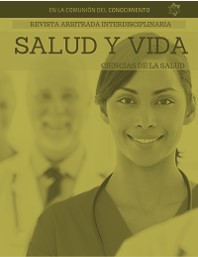Relationship between ergonomic risk and musculoskeletal symptoms
DOI:
https://doi.org/10.35381/s.v.v6i2.2125Keywords:
Risk factors, muscles, injuries. (Source, DeCS).Abstract
Objective: The working positions of the students were evaluated during the practices performed in the Dental Care Unit and on the basis of which musculoskeletal problems are presented at the vertebral column level. Method: Descriptive observational. Results: 83% of the students had the greatest discomfort in the neck, followed by 71% in the wrists, 68% in the upper back, 59% in the lower back and 51% in the shoulders, due to the postures that this type of profession forces them to maintain. Conclusion: The most affected part of the body due to the postures presented by the 10th semester students who perform their pre-professional practices at the UAO of UNIANDES, is the neck, forearm and trunk, this is due to the activities and the way in which they perform them during their professional life, 41% require immediate action and 46% require prompt action.
Downloads
References
Sonne M, Villalta DL, Andrews DM. Development and evaluation of an office ergonomic risk checklist: ROSA--rapid office strain assessment. Appl Ergon. 2012;43(1):98-108. doi:10.1016/j.apergo.2011.03.008
Liebregts J, Sonne M, Potvin JR. Photograph-based ergonomic evaluations using the Rapid Office Strain Assessment (ROSA). Appl Ergon. 2016;52:317-324. doi:10.1016/j.apergo.2015.07.028
Lima TM, Coelho DA. Prevention of musculoskeletal disorders (MSDs) in office work: a case study. Work. 2011;39(4):397-408. doi:10.3233/WOR-2011-1190
Ordóñez-Hernández CA, Gómez E, Calvo AP. Desórdenes músculo esqueléticos relacionados con el trabajo [Work-related musculoskeletal disorders]. Rev Colomb Salud Ocup [Internet]. 2021;6(1):27-32. Disponible en: https://revistas.unilibre.edu.co/index.php/rc_salud_ocupa/article/view/4889
Picha KJ, Jochimsen KN, Heebner NR, et al. Measurements of self-efficacy in musculoskeletal rehabilitation: A systematic review. Musculoskeletal Care. 2018;16(4):471-488. doi:10.1002/msc.1362
Mottin AC, de Miranda CA, Pagnan CS, Monken OP. Ergonomic analysis of workplaces in the iron casting industrial pole in Claudio, Minas Gerais--Brazil. Work. 2012;41 Suppl 1:1727-1732. doi:10.3233/WOR-2012-0376-1727
Błaszczyk A, Ogurkowska MB. The use of electromyography and kinematic measurements of the lumbar spine during ergonomic intervention among workers of the production line of a foundry. PeerJ. 2022;10:e13072. Published 2022 Mar 18. doi:10.7717/peerj.13072
Kataria KK, Sharma M, Kant S, Suri NM, Luthra S. Analyzing musculoskeletal risk prevalence among workers in developing countries: an analysis of small-scale cast-iron foundries in India. Arch Environ Occup Health. 2022;77(6):486-503. doi:10.1080/19338244.2021.1936436
Kataria KK, Sharma M, Mohan Suri N, Kant S, Luthra S. Analyzing musculoskeletal risk-severity among small scale casting workers using ergonomic assessment tools: A statistical approach. Work. 2022;72(4):1429-1442. doi:10.3233/WOR-210867
Saraceni N, Kent P, Ng L, Campbell A, Straker L, O'Sullivan P. To Flex or Not to Flex? Is There a Relationship Between Lumbar Spine Flexion During Lifting and Low Back Pain? A Systematic Review With Meta-analysis. J Orthop Sports Phys Ther. 2020;50(3):121-130. doi:10.2519/jospt.2020.9218
Khodadad B, Letafatkar A, Hadadnezhad M, Shojaedin S. Comparing the Effectiveness of Cognitive Functional Treatment and Lumbar Stabilization Treatment on Pain and Movement Control in Patients With Low Back Pain. Sports Health. 2020;12(3):289-295. doi:10.1177/1941738119886854
Orita S, Inage K, Eguchi Y, et al. Lumbar foraminal stenosis, the hidden stenosis including at L5/S1. Eur J Orthop Surg Traumatol. 2016;26(7):685-693. doi:10.1007/s00590-016-1806-7
Goubert D, Oosterwijck JV, Meeus M, Danneels L. Structural Changes of Lumbar Muscles in Non-specific Low Back Pain: A Systematic Review. Pain Physician. 2016;19(7):E985-E1000.
Turci AM, Bevilaqua-Grossi D, Pinheiro CF, Bragatto MM, Chaves TC. The Brazilian Portuguese version of the revised Maastricht Upper Extremity Questionnaire (MUEQ-Br revised): translation, cross-cultural adaptation, reliability, and structural validation. BMC Musculoskelet Disord. 2015;16:41. Published 2015 Feb 25. doi:10.1186/s12891-015-0497-2
Rodrigues MS, Sonne M, Andrews DM, Tomazini LF, Sato TO, Chaves TC. Rapid office strain assessment (ROSA): Cross cultural validity, reliability and structural validity of the Brazilian-Portuguese version. Appl Ergon. 2019;75:143-154. doi:10.1016/j.apergo.2018.09.009
Published
How to Cite
Issue
Section
License
CC BY-NC-SA : Esta licencia permite a los reutilizadores distribuir, remezclar, adaptar y construir sobre el material en cualquier medio o formato solo con fines no comerciales, y solo siempre y cuando se dé la atribución al creador. Si remezcla, adapta o construye sobre el material, debe licenciar el material modificado bajo términos idénticos.
OAI-PMH: https://fundacionkoinonia.com.ve/ojs/index.php/saludyvida/oai.









